In understanding the economics behind credit cards, assessing manufacturing costs is a fundamental step.
This analysis delves into the key components and expenses involved in producing a credit card, shedding light on the intricate pricing structure of this ubiquitous financial tool.
How Much Does It Cost to Manufacture a Credit Card?
The production cost of a standard credit card ranges from $.90 to $1.40. However, dual interface cards, which include NFC technology, incur higher expenses, around $2 to $2.50 per card.
This explains why banks readily replace cards when requested, as the economics behind their creation play a significant role.
Cost-Related Factors in Manufacturing a Credit Card
Manufacturing a credit card involves a range of intricate cost-related considerations, each contributing to the final price of this ubiquitous financial tool. From basic card features to advanced technologies, several key factors influence the expenses incurred in producing credit cards.

Card Type and Features
The type of credit card and its associated features play a pivotal role in determining manufacturing costs. Standard credit cards with magnetic stripes and basic embossed information tend to be more cost-effective, typically ranging from $.90 to $1.40 per card.
However, specialized cards offering enhanced security features, personalized designs, or unique materials can substantially increase production costs.
Technological Advancements
The integration of advanced technologies significantly impacts the cost structure of credit card manufacturing. Cards equipped with Near Field Communication (NFC) technology for contactless payments or dual interfaces (both contact and contactless) can cost between $2 and $2.50 per card.
The inclusion of these technologies involves intricate manufacturing processes and electronic components, contributing to higher overall expenses.
Materials Used
The choice of materials is a crucial determinant of credit card production costs. While standard plastic remains a cost-effective option, some institutions opt for premium materials like metal or composite materials to enhance durability and aesthetics.

The selection of these materials affects the initial manufacturing expenses, potentially raising the overall cost per card.
Security Features
Security remains a paramount concern in credit card manufacturing. Incorporating security elements such as holograms, embedded chips [1], and unique identifiers adds an extra layer of protection against fraud.
However, these security measures come with additional production expenses, impacting the final cost of the card.
Customization and Personalization
Personalized credit cards, featuring individual names, images, or design preferences, necessitate specialized printing processes. These customization options increase the complexity of manufacturing, leading to higher costs per card.
The level of personalization required directly correlates with the overall expenses incurred.
Quantity Produced
Economies of scale also play a role in credit card manufacturing costs. Producing larger quantities of cards often results in reduced costs per unit due to optimized production processes.

Conversely, smaller batches might incur higher expenses, as the manufacturing setup and processes need to be adjusted accordingly.
Conclusion
In unraveling the intricacies of credit card production costs, it becomes evident that diverse factors contribute to the final expense.
From technology integration to security measures and material choices, each element plays a role in shaping the economics behind manufacturing these ubiquitous financial instruments.

